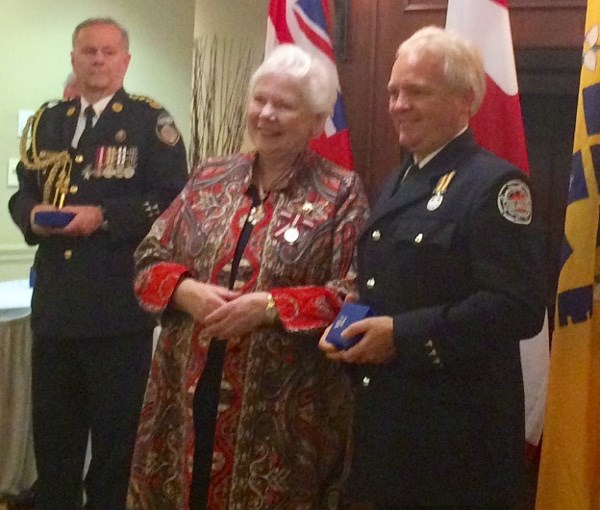Brian Haines is both humble and proud.
The Sault Ste. Marie EMS paramedic was one of 38 Ontario paramedics who received recognition for 30 years of service from Lieutenant Governor Elizabeth Dowdeswell at a ceremony in Toronto on Monday, Oct. 23.
Haines began his career in 1987 as a paramedic in Collingwood, Ontario, continuing his career in Grey County before relocating to the Sault in 2005 with his wife (who has family members in town).
The story of what led Haines to be a paramedic is interesting.
“I stopped one time at the scene of a single-vehicle accident in the middle of winter (in his hometown of Meaford, near Owen Sound in 1985), it happened basically right in front of me,” Haines told SooToday.
“The paramedics showed up very shortly afterward, so I actually helped them get the patient out the vehicle, put a collar on his neck, put him on a backboard and helped them carry him out the ditch.”
“There was a lot of snow so I thought ‘I think the guys could use the help’ and I think they appreciated it.”
“One of the paramedics was a gentleman named Leonard Smith who retired years ago, and I remember him saying to me at the back of the ambulance ‘you did really good son. Have you ever thought about doing this? I think you’d make a good paramedic.’”
“So I thought ‘I could see myself being a paramedic and helping people,’” Haines said.
“Being a paramedic is important to me because of the satisfaction you get in helping others.”
And, helping others is indeed what Haines has done.
Apart from saving lives throughout his career, Haines has helped bring lives into the world as well.
“There’ve been a lot of ‘wow’ feelings. I’ve helped deliver six babies over the course of my career,” Haines recalled.
“They also used to give us a pin down in Collingwood and Meaford whenever you’d save someone in cardiac arrest. I’ve had at least a dozen of those where people have been almost dead, you shock them and get them back.”
Haines said there are some emergency calls which remain in his memory more than others, “but they’re graphic. You see a lot of bad stuff.”
“The thing that sticks out in my mind the most is the frustration you feel when you’re at the scene of an accident caused by an impaired driver, and distracted driving, people on their cell phones…when people die as a result of that.”
“It’s such a preventable thing.”
“The baby deliveries, and being able to bring somebody back who is in cardiac arrest, they’re the most gratifying calls, and especially when you’re able to meet survivors afterward, you often get to meet them, you get a hug from the wife of the gentleman you’ve revived.”
“It’s pretty touching, because you’ve been there when they’re at the worst point in their life, and you’re able to help and bring about a positive outcome.”
Paramedics think fast and clearly when at the scene of an emergency, but like other first responders, how does a paramedic deal with the emotional after effects (especially after a crash victim, for example, passes away in spite of a paramedic’s best efforts)?
“When you lose a life, whether it’s a baby or adult, I think you have to get to the point where you have enough confidence in your own ability to know you’ve done everything you can do, and in spite of your best efforts, people do sometimes die, and you can’t blame yourself for something that was outside of your control.”
“The spouse of a paramedic, they carry a lot too.”
“I think the help of your spouse and talking with your co-workers (helps).”
Haines advises younger paramedics to talk through their difficult calls with their peers (in fact, EMS has a peer support program in place).
Haines, 54, previously received an honour for 20 years of service.
The Oct. 23 ceremony in which he received his 30-year service bar for his original medal, Haines said, “was very humbling, actually.”
“The Lieutenant Governor said collectively, among the recipients in the room, there was 1,000 years of experience, because there were 38 people there. It’s pretty amazing, pretty humbling to be in a group of people who have dedicated their careers to helping others, humbling but also a proud moment for sure.”
A group of other Ontario paramedics received bars for 40 years of service Oct. 23.
The Emergency Medical Services Exemplary Service Medal was created in 1994 by the late Governor General Romeo LeBlanc as a component of the Canadian Honours System.
To qualify, at least 10 of these years of service must have been street level (or air) duty involving potential risk to the individual.
“I’ve enjoyed being a paramedic in the Sault,” Haines said.
“It’s definitely so much busier here than in the other services I’ve worked in. Our call volume continues to climb by approximately 1,000 calls every year. We definitely could use more ambulances, no doubt about it, because geographically we have a huge area to cover, but I do like working here.”
“It’s been gratifying. I couldn’t imagine doing anything else.”
